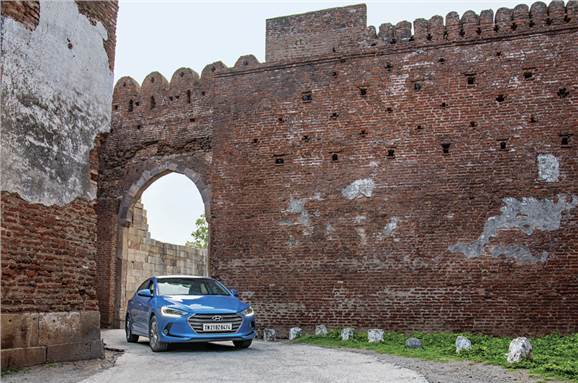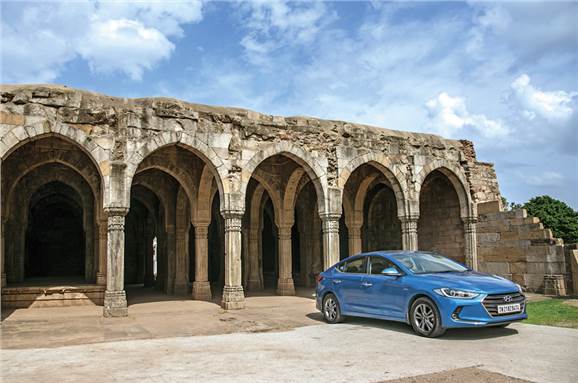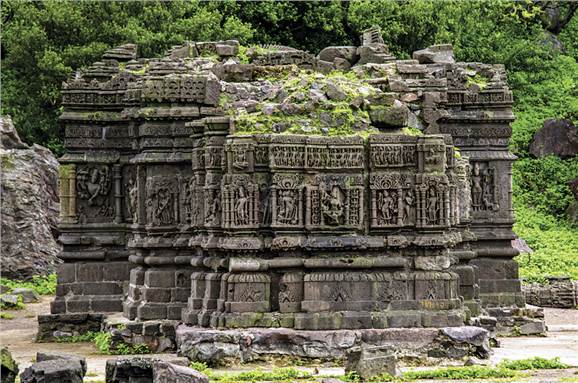A Heritage of Prestige
Priyadarshan takes the Hyundai Elantra to find interesting places off the beaten path, less known to the general public.
Published On Aug 18, 2017 03:28:00 PM
8,567 Views
Follow us onNestled at the bottom of Pavagadh is the unassuming little town of Champaner. Even though it’s a place that’s steeped in history, you could drive right past it and not take in more than some of the ancient stone walls still standing tall around the quaint village-style houses. In fact, determined to visit the temples that litter the top of Pavagadh hill, we almost failed to notice some incredible historical monuments as we whizzed past in the Hyundai Elantra. As the car’s built-in navigation system attested, twisty roads were in store going up the hill and when you have 152hp at the beck and call of your right foot, it’s nigh on impossible to pass up a chance to have some corner-carving fun.
Thankfully, better sense – or rather the need to eat some breakfast – prevailed, and we happened to stop at the row of food vendors right outside an intriguing, arched gate. Inside was something exceptional – a true-blue UNESCO World Heritage site rich with pre-Mughal era structures, which everyone whom we had asked about the area had utterly failed to mention. But it is exactly what we were looking for – a true hidden gem.
The objective behind this road trip was to find interesting places to visit which lie off the beaten path; places which, for some reason or the other, have remained lesser known to the general public. Of course, no epic road trip is complete without an epic car, and for this mission, we picked the Hyundai Elantra. Hyundai’s philosophy ‘New Thinking, New Possibilities’ lined up perfectly with our need to think beyond the conventional when selecting a destination, and after much research and deliberation, the Champaner-Pavagadh region popped up on our radar.

Getting there
Located about 50km from the city of Vadodara in Gujarat, Champaner was approximately a seven-hour drive from our starting location, Mumbai. Now, normally, most people would choose a diesel car for a journey of this distance. But us city boys love refined cars, so it was the 2.0-litre petrol-engined Elantra for us; the six-speed automatic at that! And good choice too, as with no clutch to operate, getting out of Mumbai through its ever-crowded Western Express Highway proved to be a surprisingly relaxing experience. And once we hit the open stretches of NH-8, the motor had more than enough poke to make short work of the truck traffic that plies this highway. The kilometres just flew by rapidly and, a little after sundown, we reached our pit stop for the day, Vadodara, where a traditional Gujarati thali for dinner was just what the doctor ordered. Champaner would have to wait till morning.
The Vadodara-Halol highway is a beautiful stretch of four-lane tarmac that is the final stretch to cover before you get to Champaner. And when we left from Vadodara at the crack of dawn, the highway was absolutely devoid of any traffic, which meant that it was the perfect time to engage in some Sport mode shenanigans with the Elantra. The push of a button on the centre console next to the driver cycles between the Standard, Eco and Sport settings for the Elantra’s throttle response and gear shift program. With Sport mode enabled, the motor instantly reacts to any inputs to the accelerator pedal and the gearbox holds each gear as the four-cylinder engine screams to its redline. While a lot of driving enthusiasts might shrug off automatic gearboxes in general, the Elantra proved to be quite an entertaining driving experience in getting us to our destination.
Forgotten History
Champaner-Pavagadh became one of India’s now 36 UNESCO World Heritage Sites back in 2004, and is home to a concentration of largely unexcavated archaeological, historic and living cultural heritage sites cradled in an impressive landscape. Traces of human life here date back to the Chalcolithic, or Copper Age, with major settlements arriving by the eighth century CE. Hindu and Jain temples from that era still exist in the area, many continuously repaired over time and still active sites for worship, while others lie in a dilapidated condition. In 15th century CE, Champaner was taken over by pre-Mughal Muslim rulers, and even served as the capital of their kingdom until the arrival of the Mughals. There isn’t much record of what followed for several centuries after, but Champaner fell into rapid decline and was largely abandoned, neglected and almost deserted by the time the British ‘rediscovered’ it in the early 19th century. At this time, the once great city was home to only about 500 people. It was only by the end of the 19th century that Champaner was somewhat reinstated in public psyche.
Currently, the fortified walls of the royal precinct still stand in reasonably good shape, and as we drove the Elantra through the gate of this enclosure, the spectacle of the Sahar Ki Masjid came into view. This private mosque that was built for the royal family and nobles of the Gujarat Sultanate has five domes and two minarets – clear influences of Islamic architecture. But as we entered the central prayer hall, it almost felt like we had walked into an ancient Hindu temple, with its column-and-beam construction.
This same blend of Hindu and Islamic architecture can be seen on all the mosques around the Champaner-Pavagadh area – there are in fact nine major ones, with a few of them remarkably well-preserved. The most imposing one of these is the Jami Masjid, with minarets towering almost 100 feet high, located just outside the walled area. The two-storey structure is massive, with almost 200 pillars supporting it from inside the main prayer hall.

At the centre of Champaner is a square structure with high arches known as ‘Mandvi’, which is said to have functioned as everything from an exclusive and separate enclosure for royalty visiting as guests of the kings to an octroi or custom house. Peeping through the arches, we got our first real view of modern-day Champaner – almost a shanty town at this point.
Up the hill
With such centuries long and multicultural history behind it, the Champaner-Pavagadh region is alsohost to many temples, some of them dating back to over a thousand years. The Kalika Mata temple is located right at the 800 metre high summit of the Pavagadh hills. And getting here first involved driving up a wonderful twisty mountain road, which proved to be a lot of fun in the Elantra. Sticking the automatic gearbox in its tiptronic setting allowed us to manually call in gear changes as we tackled the numerous hairpin turns getting up to the ‘Machi’ – a plateau which serves as the last point motor vehicles can reach.
The thought of leaving the Elantra at the Machi parking did leave us a little sad, but at least we
could take the ropeway to get to the temple areas instead of climbing several thousand steps. The Pavagadh ropeway is stated to be the country’s highest one, and we had no trouble believing that as the ground below us dropped away rapidly and our little carriage entered the clouds. The final climb to the temple, however, has to be done via steep steps that really tested our endurance.
The top of Pavagadh is very similar to most active religious sites around the country – overcrowded and generally ill-maintained. It’s a bit tragic that so many of the people who do this pilgrimage have absolutely no idea of the historical significance of the region. Caught in a narrow focus that most faith demands, an absolute treasure trove of the past lies completely ignored by the thousands who visit. In some ways though, this seems to be the saving grace for Champaner’s monuments. Bereft of too much human presence, they seem to have stood the test of time rather well. And they might stand strong for centuries to come as well.

Now Hyundai has a CSR initiative called ‘Happy Move’ which involves volunteer youths from South Korea and India and is aimed at saving and taking care of heritage sites in India. While the initiative is focussed on historic monuments around Delhi at the moment, it made us contemplative on the drive back about how we all need to play our part in preserving our history – whether by aiding the upkeep of such monuments, or just by visiting them to soak in the history. And there’s simply a lot to absorb in Champaner in just a day’s visit. The place is a must visit for anyone with even a passing interest in history and culture, and even those seeking an escape to a beautiful destination away from the throngs of humanity that besiege us in our cities. As for us, we were just left humbled and amazed by the magic of Champaner and Pavagadh.
Travel Tips #1
Accessing Champaner-Pavagadh Archaeological Park
Drive: 50km east of Vadodara, via Halol highway
Champaner to Pavagadh:
- Drive to Machi car park
- Trek five kilometres up to temple area orropeway up to it at Rs 110 per person
- Walk final ascent to Kalika Mata temple
Travel Tips #2
Must-see at Champaner-Pavagadh Archaeological Park
- Jami Masjid
- Sahar Ki Masjid
- Lakulisa temple
- Kalika Mata temple
- Sikandar Shah’s tomb
- Mandvi
- Sat Manzil
Copyright (c) Autocar India. All rights reserved.




















Comments
Member Login
Personal Details
No comments yet. Be the first to comment.